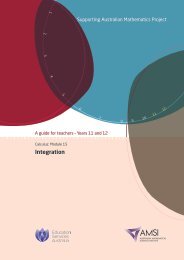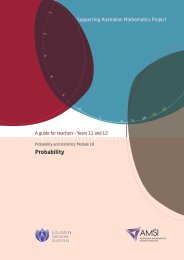Quadratics - the Australian Mathematical Sciences Institute
Quadratics - the Australian Mathematical Sciences Institute
Quadratics - the Australian Mathematical Sciences Institute
You also want an ePaper? Increase the reach of your titles
YUMPU automatically turns print PDFs into web optimized ePapers that Google loves.
A guide for teachers – Years 11 and 12 • {33}<br />
after a little algebra. Also,<br />
ST 2 = (a + ap 2 ) 2 = a 2 (1 + p 2 ) 2<br />
and so SP = ST . Hence ∆ST P is isosceles and so ∠ST P = ∠SPT .<br />
Thus <strong>the</strong> reflection property tells us that any ray<br />
parallel to <strong>the</strong> axis of <strong>the</strong> parabola will bounce off<br />
<strong>the</strong> parabola and pass through <strong>the</strong> focus. Conversely,<br />
any ray passing through <strong>the</strong> focus will reflect<br />
off <strong>the</strong> parabola in a line parallel to <strong>the</strong> axis<br />
of <strong>the</strong> parabola (so that light emanating from <strong>the</strong><br />
focus will reflect in a straight line parallel to <strong>the</strong><br />
axis).<br />
S<br />
Links forward<br />
Conic sections<br />
The parabola is one of <strong>the</strong> curves known as <strong>the</strong> conic sections, which are obtained when<br />
a plane intersects with a double cone.<br />
The non-degenerate conic sections are <strong>the</strong> parabola, ellipse, hyperbola and circle.<br />
Parabola<br />
y<br />
y2 = 4ax<br />
Ellipse<br />
y<br />
b<br />
x 2<br />
y 2<br />
a + = 1<br />
2 b 2<br />
0<br />
x<br />
–a a<br />
0<br />
x<br />
–b<br />
Hyperbola<br />
y<br />
–a a<br />
0<br />
x 2<br />
y 2<br />
a – 2 b = 1 2<br />
x<br />
Circle<br />
y<br />
a x2 + y2 = a2<br />
–a a<br />
x<br />
–a
















